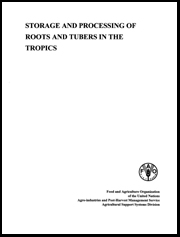
Prepared by:
Aliou DIOP, Post-harvest Technologist
Edited by
D.J.B. Calverley, Consultant
January 1998
Food and Agriculture Organization of the United Nations
Agro-industries and Post-Harvest Management Service
Agricultural Support Systems Division
© FAO 1998
All rights reserved. No part of this publication may be reproduced, stored in a retrieval system, or transmitted in any form or by any means, electronic, mechanical, photocopying or otherwise, without the prior permission of the copyright owner. Applications for such permission, with a statement of the purpose and extent of the reproduction, should be addressed to the Director, Publications Division, Food and Agriculture Organization of the United Nations, Viale delle Terme di Caracalla, 00100 Rome, Italy.
This electronic document has been scanned using optical character recognition (OCR) software and careful manual recorrection. Even if the quality of digitalisation is high, the FAO declines all responsibility for any discrepancies that may exist between the present document and its original printed version.
1.1 Root and Tuber Crops Production
1.2 The Role of Roots and Tubers in Nutrition
1.3 Consumption Patterns for Roots and Tubers
1.4 General Characteristics of Root and Tuber Crops1.4.1 Cassava (Manihot esculenta Crantz)
1.4.2 Yams (Dioscorea spp.)
1.4.3 Sweet potato (Ipomoea Batatas L.)
1.4.4 Potato (Solanum tuberosum L.)
1.4.5 The edible aroids
Chapter 2 - Factors Affecting Storability of Roots And Tubers
2.1 Mechanical Damage
2.2 Physiological Factors2.2.1 Respiration
2.2.2 Transpiration or evaporation of water from tubers
2.2.3 Dormancy and sprouting
2.2.4 Pathological factors
2.2.5 Attacks by pests
2.2.6 Damage by extremes of temperatures
Chapter 3 - Principles of Storage for Roots and Tubers
3.1 Control of Mechanical Damage
3.1.1 Curing of root and tuber crops
3.1.2 Proper packaging and handling3.2 Control of Temperature
3.3 Control of Sprouting3.3.1 Storage at low temperatures
3.3.2 Gamma irradiation (Table 3.3)
3.3.3 Chemical sprout inhibitors3.4 Control of the Spread of Diseases
3.5 Control of Damage Caused by Insects
3.6 Control of Nematodes
Chapter 4 - Handling and storage methods for Fresh Roots and Tubers
4.1 Storage of Fresh Cassava Root
4.1.1 Preparing fresh cassava roots for storage
4.1.2 Traditional storage methods for fresh
4.1.3 Improved low-cost storage methods for fresh cassava
4.1.4 Improved higher cost techniques4.2.1 Preparing yams for storage
4.2.2 Traditional yam storage methods
4.2.3 Improved low-cost storage methods
4.2.4 Higher cost improved yam stores4.3 Storage of Potatoes (S. Tuberosum)
4.3.1 Consideration of storage requirements
4.3.2 Preparing ware potatoes for storage
4.3.3 Low-cost ware potato storage
4.3.4 Seed potato storage
Chapter 5 - Processing of Roots and Tubers
5.1.1 Production of dehydrated chips
5.1.2 The processing of cassava into gari
5.1.3 The processing of cassava into "farinha de mandioca"
5.1.4 The production of cassava bread
5.1.5 The production of attieke5.2 Processing of other Root and Tuber Crops
5.2.1 Traditional methods
5.2.2 Improved methods of production of dehydrated chips
Appendix One - Approximate nutrient levels of various staple
Appendix Two - A comparison of three technologies for the production of gari